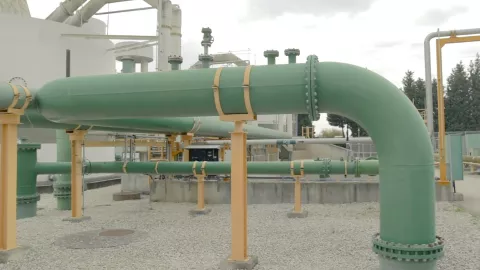It is the most abundant chemical element. Hydrogen is present in our body, in the air we breathe, in the water we drink, but also in plants and animals, as well as in the stars and planets that make up the universe. Lighter than air, colorless, odourless and extremely flammable, hydrogen is, despite its simplicity, one of the greatest hopes for the future of the planet.
Green hydrogen, without any polluting emissions associated with its use and production, is one of the final stages of a five-century scientific and technological journey. And it is a safe bet towards global energy efficiency and carbon neutrality goals.
What is Hydrogen?
Hydrogen (H2) is the first chemical element in the periodic table. It is also the lightest and simplest element, as it consists of an atom comprising only an electron around a proton. Hydrogen is basically a component of other elements and structures. It cannot be extracted, so its full potential requires industrial-based production.
António Vidigal from EDP Inovação points out that "hydrogen is not an energy source. Like electricity, it is a carrier, an energy carrier." And as a carrier, H2 "complements electricity, and can be used for a range of uses that are not electrifiable." Much of H2's transformative power lies in this versatility.

Swiss physician and alchemist Paracelsus was the first to come across hydrogen in his scientific experiments in the 16th century. However, he was unable to identify the substance.
Hydrogen can be produced in multiple ways, but two methods stand out: steam reforming, which is still the most commonly used method, and water electrolysis, whose potential is beyond doubt.
Steam reforming: In the most widely used technique today, hydrogen is obtained by heating a fossil fuel - usually natural gas - at high temperatures. Contact with water steam causes hydrogen molecules to separate, which also releases carbon dioxide (CO2). Ways to make this technique more efficient include using biomass as a source of methane to serve as fuel, and capturing the emitted CO2.
Water electrolysis: When passing electric current through water in an electrolyzer, it decomposes into its constituent elements - oxygen and hydrogen. If using electricity from renewable sources, this process produces green H2. The electrolyzer always works with a cathode, which "concentrates" hydrogen bubbles, and an anode, where oxygen is added.
But there are three different types of electrolysers:
- Alkaline, which uses sodium and potassium hydroxide in water to accelerate the separation of molecules, at a temperature of 80ºC;
- PEM, with a polymer membrane that separates the two parts of each electrolyser cell. At 80°C too, hydrogen protons cross the membrane to one side, leaving oxygen on the other;
- SOEC, which uses a solid oxide partition, a ceramic material that is crossed by oxygen to the side of the anode, leaving the hydrogen in the initial half. This technique works at higher temperatures, 500°C.
Hydrogen production requires a large amount of electricity - 55kWh and 9 liters of water to produce 1 kg of H2 -, so reducing its end price will depend on the development of the technology and the constant growth of renewable energies. "The biggest problem right now is the ability to scale up the industry that manufactures electrolyzers," says António Vidigal, adding that 70% of the cost of electrolyte hydrogen goes into the energy used for its production. He points out that "existing systems are in the order of tens of MW, and we want to start building electrolyzers with hundreds and even thousands of MW."

In 1766 English scientist Henry Cavendish identified gas as a 'flammable air' and argued that it releases water after burning. In 1783 Antoine Lavoisier coined the name 'hydrogen', in reference to the Greek words for 'water maker'.
Despite all the myths about hydrogen, H2 can be used in industry, mobility and heating, but also for producing electricity. António Vidigal believes it is "an ally of electricity, because it makes it possible to store it - a critical aspect when operating a system focused on renewable energies, which have an intermittent nature." It is an option for balancing electricity capacity/needs according to greater demand or excess production in the field of renewable energy.
To space and beyond
Two aspects have been explored since the early days of hydrogen studies: that it is extremely flammable, and that it is extremely light. It is therefore no wonder that as early as 1807, hydrogen was at the origin of the first internal combustion engine. French inventor Isaac de Rivaz used a mix of hydrogen and oxygen as fuel. More than a century later, H2 was being used in NASA's Apollo missions to the moon. Combined with oxygen in fuel cells that generate electricity, it can feed engines, electrical systems in vehicles, and other equipment.

H2 has an energy capacity almost three times higher than conventional fuels. In other words, 1 kg of hydrogen is equivalent to almost 3 kg of diesel or petrol.
Also, after decades of experiments with balloons, given that this gas has a lower density than helium, the first dirigible airship was created in 1852 by another Frenchman, Henri Giffard. It paved the way for an evolution that put hydrogen-fueled zeppelins on par with planes in the first decades of the 20th century.
The chemical and petrochemical industries, refrigeration, electricity generation, heating, fertilizer production, semiconductors, welding and metal cutting are just a few of the uses of hydrogen. But hydrogen applications in transport are not limited to space rockets. Hydrogen-fueled vehicles are a reality and it is expected that their growth - whether for road, rail, sea or air transport - will go hand in hand with advances in H2 production.

The first fuel cell-powered vehicle was the Allis-Farmers tractor in 1959, followed by the Chevrolet Electrovan van in 1966. Honda, Toyota and Hyundai are the companies that invest the most in hydrogen today.
Gas or liquid, flammable but safe
Since it is a gas in its natural form, hydrogen can be converted to liquid form if it is cooled at very low temperatures - below minus 250ºC. Scotsman James Dewar achieved this in 1898, paving the way for this new application. Furthermore, it can be combined with other materials, both for use and storage.
Hydrogen can be stored in three ways:
- As compressed gas. In tanks or reservoirs; the higher the pressure, the better energy volume they can achieve, making transportation easier. Hydrogen can be transported through pipelines - non-metallic pipelines, as H2 corrodes these materials - or in fuel-tanks and cisterns. In the future, it may be possible to reuse or replace natural gas pipelines with hydrogen, thus making these structures profitable. The underground caves that are now used for storing natural gas may also be used for H2 in the future.
- In liquid form. It is like this, stored in cryogenic chambers or tanks, that hydrogen achieves the best balance between energy volume and energy potential. However, liquefaction is an expensive process that causes losses of approximately 30%, and it is suitable for long-haul transport only.
- Integrated into sponge-like materials. Some metal hydrides, polymers or fibers enable the absorption and storage of hydrogen. The development of this technology will facilitate hydrogen use without the need for high pressures, extremely low temperatures, or large volume tanks.
Despite the fact that it is highly flammable (even in liquid form) and despite the technical complexity of keeping it at low temperatures, one of the great advantages of hydrogen is that it can be stored in the long run without deterioration or losses.
The main challenge, for now, is its volume. Scaling down storage to smaller tanks and bottles with high energy capacity - so that this can be a truly viable solution for everyday applications - will be a major turning point in the way we perceive and use energy.



